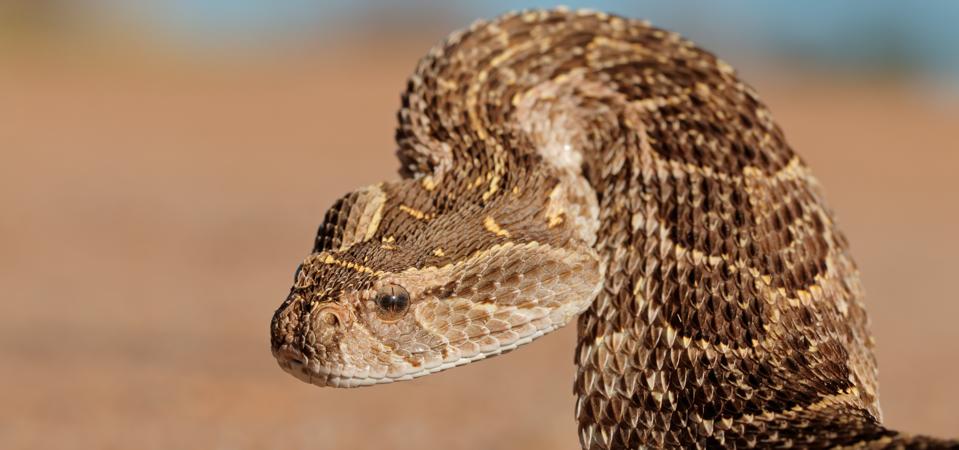A Biologist Spotlights 3 'Extreme' Snakes - By Strike Speed, Ground Speed And Air Speed

It may not come as a surprise that snakes move quickly, as their prey – often fast-moving animals – ... More demands agility. What many don’t realize, however, is just how many snakes are capable of outpacing even humans.
gettyIn Kung Fu, “striking like a cobra” symbolizes speed and precision – qualities that are quite real in the snake world. Many snakes feed on creatures like rodents, birds and other small vertebrates, all of which are impressively quick for their size.
However, contrary to popular belief, cobras aren’t the fastest strikers in the snake world. When it comes to sheer strike speed, few snakes rival the puff adder (Bitis arietans), whose deadly reputation in Africa is well-earned.
Responsible for the majority of snakebite fatalities in Africa, the puff adder strikes with both speed and precision. Its strike can reach a blistering 19 feet per second. To put that in perspective, it takes just under 90 milliseconds for the snake’s fangs to reach their target, while a typical human blink lasts around 200 milliseconds.
In other words, the puff adder can strike faster than the blink of an eye.
But while the puff adder is the meanest striker, it isn’t the fastest when it comes to locomotion – the process by which an animal physically moves through its environment. Over land and air, there are two snake species that can very well outpace humans.
The black mamba is the fastest snake on land, capable of reaching speeds up to 12 miles per hour.
gettyWhen it comes to land speed, few snakes are as fast as the black mamba (Dendroaspis polylepis). Native to sub-Saharan Africa, this long, slender, and remarkably agile species can reach speeds of 9 to 12 miles per hour over short distances, making it the fastest snake in the world on land.
Don’t be fooled by web searches claiming the sidewinder rattlesnake is the world’s fastest snake – a misconception that’s been widely perpetuated online. While sidewinding is an efficient way to move across loose desert sand, it’s not particularly fast. Biomechanical research shows that sidewinders top out at around 2.2 miles per hour on the ground.
By contrast, the black mamba's smooth lateral undulation and powerful muscular coordination allow it to traverse open ground with astonishing speed. Its movement is not only fast but also controlled and deliberate. Black mambas are often seen cruising the savanna with their head and neck held high, using their keen eyesight to scan for danger or track prey – typically small mammals such as hyraxes, bush babies, and rodents.
Despite their fearsome reputation, black mambas are not inherently aggressive. In reality, they are shy, secretive snakes that go out of their way to avoid conflict. Like most snakes, they strike only when they feel threatened or cornered.
(: Long considered the world’s second-longest venomous snake at up to 15 feet, the black mamba has recently slipped to fifth place. Curious which four venomous snakes outrank it in length? Read the full story here.)
This gorgeous paradise flying snake has the amazing ability to use its body to control a free fall. ... More By flattening its ribs, it is able to "glide" through the air, making it a very unique species of snake.
gettyThe paradise flying snake (Chrysopelea paradisi) is not capable of flight in the traditional sense, but it has evolved a remarkable ability to glide through the air, making it one of the most fascinating – and fastest moving – snakes in the world. Found in the rainforests of Southeast Asia, this snake uses its unique body structure to “fly” from tree to tree by flattening its ribs and undulating through the air.
Its gliding ability allows it to cover distances of up to 100 feet in a single leap, often traveling at speeds of up to 25 miles per hour. Measured by sheer velocity, that makes it the fastest snake in the world – though it only reaches these speeds while gliding.
The snake’s technique involves launching itself from a high point and using the air to support its long, flattened body, making it seem like it's flying. In reality, the snake is engaging in controlled freefall, steering with precise body movements to direct its glide. This specialized form of locomotion helps it escape predators, hunt for prey and move efficiently between trees in its dense forest habitat.
There are five species in the genus Chrysopelea, but only four have documented gliding behavior. The exception is the Sri Lankan flying snake (Chrysopelea taprobanica), for which data on aerial locomotion is still lacking. While the other species are all considered skilled aerial travelers, biomechanical research suggests that the paradise flying snake is the fastest glider among them.
While the paradise flying snake is venomous, its venom is mild and poses little danger to humans. Its primary diet consists of reptiles, birds and other small vertebrates, and its ability to glide gives it a distinct advantage in ambushing prey or escaping threats in the treetops.
Curious to see how your fear of animals stacks up? Take our quick quiz to find out fast-moving creatures — like snakes that strike fast, slither, swim and glide — send a shiver down your spine: Fear Of Animals Scale











